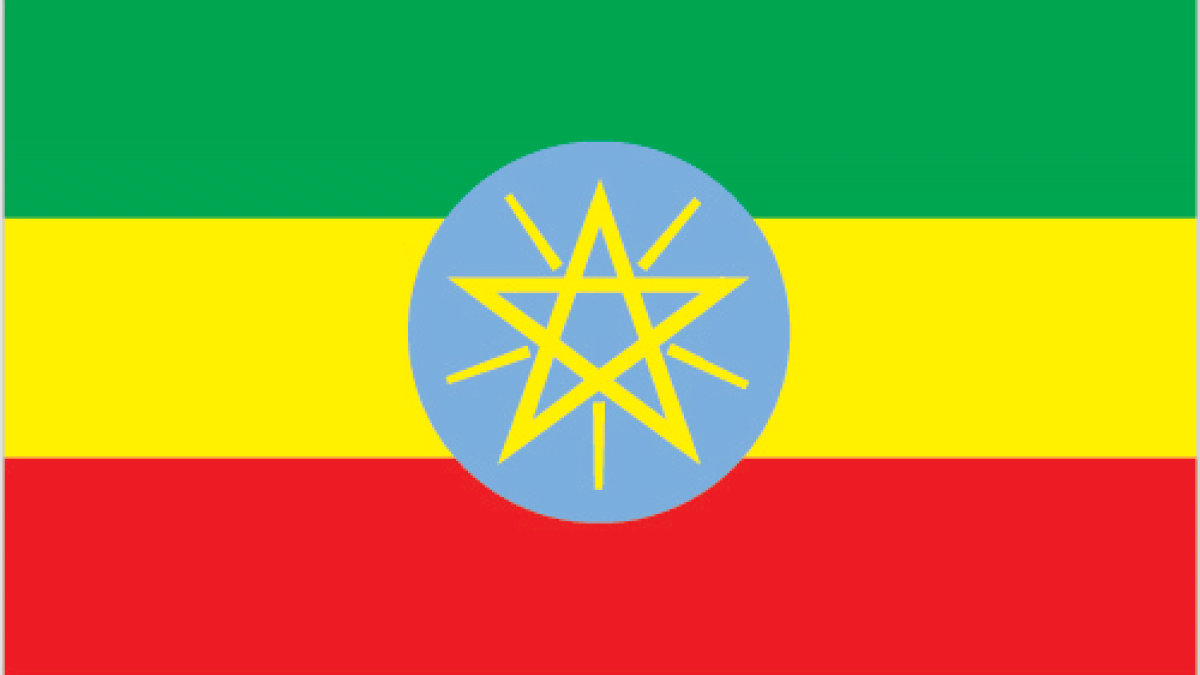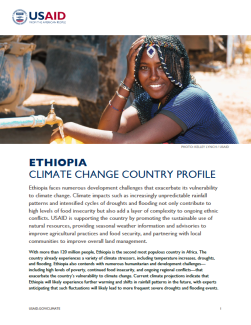FACT SHEET – Ethiopia faces numerous development challenges that exacerbate its vulnerability to climate change. Climate impacts such as increasingly unpredictable rainfall patterns and intensified cycles of droughts and flooding not only contribute to high levels of food insecurity but also add a layer of complexity to ongoing ethnic conflicts. USAID is supporting the country by promoting the sustainable use of natural resources, providing seasonal weather information and advisories to improve agricultural practices and food security, and partnering with local communities to improve overall land management.
With more than 120 million people, Ethiopia is the second most populous country in Africa. The country already experiences a variety of climate stressors, including temperature increases, droughts, and flooding. Ethiopia also contends with numerous humanitarian and development challenges——including high levels of poverty, continued food insecurity, and ongoing regional conflicts—that exacerbate the country’s vulnerability to climate change. Current climate projections indicate that Ethiopia will likely experience further warming and shifts in rainfall patterns in the future, with experts anticipating that such fluctuations will likely lead to more frequent severe droughts and flooding events. These changes will pose significant challenges for Ethiopia’s food and water security, crop production, livestock, and human health—particularly given the country's reliance on rain-fed agriculture.
Government of Ethiopia Climate Priorities
In 2023, as part of the country’s updated enhancement to its first Nationally Determined Contribution under the Paris Agreement, the Government of Ethiopia announced ambitious emissions cuts and other commitments, including:
- Reducing greenhouse gas emissions by 69 percent by 2030;
- Reforesting and restoring up to 15 million hectares;
- Applying 40 climate adaptation interventions across agriculture, water, forestry, transportation, urban, and health sectors, and;
- Investing in climate-resilient infrastructure to reduce the potential effects of flooding.
In 2024, the World Bank approved the Ethiopia First Sustainable and Inclusive Growth Development Policy Operation, which calls for the Government of Ethiopia to advance structural reforms to improve financial stability and financial sector competition, increase fiscal transparency, and improve public spending effectiveness and the performance of state-owned enterprises.
USAID’S Climate Change Program: Objectives and Results
USAID supports Ethiopia’s development and climate priorities through a series of interlinked activities and partnerships. USAID is currently partnering with Ethiopian communities across the country to promote soil and water conservation, while also protecting critical watersheds and promoting the sustainable use of water resources. By using innovative technologies, USAID also forecasts weather patterns to predict potential droughts or other climate shocks in order to strengthen disaster risk planning and improve food security.
USAID also invests in promoting the sustainability of Ethiopia’s pastoral and agricultural sectors by partnering with local pastoral communities to improve regenerative rangeland management and invasive plant species control. (In an Ethiopian context, regenerative rangeland management often means regulating livestock grazing to avoid overgrazing, which allows for soil and water quality improvements.) USAID also enhances disaster risk management practices across the country by helping communities invest in climate-resilient livelihoods and more effectively prepare for climate shocks. All told, these investments strengthen food security for millions of Ethiopia’s most vulnerable citizens.
Key Activities and Results
USAID supports Ethiopian communities and households to adapt and respond to climate change impacts. As the cycle of droughts, floods, and other climate-related shocks has accelerated, USAID invests in improved disaster risk management, preparedness, and response.
USAID also works to ensure sustainable watersheds, rangelands, agriculture, and community land management practices to address the drivers of land-use change, promote sustainable livelihoods, and increase the effectiveness of environmental policies. Protecting forests and other key ecosystems not only sustains livelihoods and mitigates climate change risks, but also maintains environmental services like biodiversity preservation, carbon capture, and water purification.
Key Results
USAID has helped:
- Support regional disaster risk management bureaus and offices to develop action plans that strengthen disaster risk management systems in 36 districts
- Improve natural resource management on nearly 245,000 hectares of grazing lands
- Strengthen food security and drought resilience, with households actively participating in USAID resilience interventions in Ethiopia’s lowlands experiencing a 50 percent lower decline in food security than non-participating households during a prolonged 2015-17 drought
- Introduce sustainable and climate-smart production management techniques to more than 224,000 farmers and agro-pastoralists to help them more effectively manage their farms and livestock
- Promote partnerships empowering more than 570 new private sector businesses to expand input and output agricultural markets in USAID’s resilience focus zones, resulting in more than $14 million in sales
- Construct irrigation systems to help more than 1,000 households gain access to water for their farms, while rehabilitating and building water systems to bring potable water to more than 12,000 people and reduce their time spent collecting water by 86 percent
- Invest in soil and water conservation of more than 63,610 hectares, including planting more than 42 million tree seedlings
- Map 4 million hectares of rangeland using satellite vegetation data to enable herders to more effectively manage their grazing lands
- Support 36 sub-districts to develop community-level disaster risk management assessments and action plans, while also providing training to enhance climate vulnerability analysis
Key Activities
USAID’s Household Economy Activity
This activity uses novel methods to identify vulnerable households and provide climate-related monitoring, analysis, forecasting, and early warning capacity to local communities and local disaster risk management authorities.
USAID’s Response Leadership Activity
This activity partners with young professionals to build a corps of disaster risk management professionals equipped with the skills to strengthen climate- and disaster risk analysis and improve community-based contingency planning.
Dynamic Research-Informed System for Managing Risk
USAID uses this framework and tool to enhance risk management in its programs, particularly in complex and dynamic environments. It is not just a static tool, but rather a systematic approach for integrating real-time data, research, and analysis into risk management practices.
>USAID’s Resilience in Pastoral Areas Activities
These activities increase climate-resilient growth in Ethiopia’s lowlands and promote livelihood diversification and support regional disaster risk management bureaus as they develop action plans that strengthen disaster risk management systems. This wide-ranging work also improves natural resource management, livestock and crop productivity, access to finance and markets, private sector engagement, water supply, nutrition, drought tolerant crops, local use of weather information, and access to weather-based livestock insurance products.
>USAID’s Resilience Food Security Activities
These activities improve both rangeland and watershed management by restoring degraded communal lands and promoting sustainable land management techniques—such as terracing, moisture conservation, and rainwater harvesting—to promote more sustainable ecosystems.
USAID’s Climate Resilient Water, Sanitation and Hygiene
This activity will expand access to improved water and sanitation for targeted lowland areas, which includes the Afar, Oromia, South Ethiopia, and Somali regions. The activity facilitates catalytic investments while piloting and scaling up innovative service and business models, strategic partnerships, and stakeholder collaborations.
USAID EPIDEMIA Early Warning System for Malaria
Responding to a challenge from the Government of Ethiopia, and as part of an extensive investment in the climate-health nexus, USAID’s Adaptation Thought Leadership Assessments project partnered with USAID/Ethiopia, the President’s Malaria Initiative (PMI), and the University of Oklahoma to support the scaling up of an existing malaria early warning system in Ethiopia—the Epidemic Prognosis Incorporating Disease and Environmental Monitoring for Integrated Assessment (EPIDEMIA) tool.
Feed the Future Global Supporting Seed Systems for Development Activity
This activity promotes climate-smart agricultural practices and technologies, while also increasing access to improved agricultural inputs that contribute to soil and water conservation and increasing access to (and the availability of) drought-resistant seeds.
USAID/Ethiopia Biodiversity and Community Resilience in the Omo Valley Activity
This activity improves biodiversity, livelihood security, and human rights in Ethiopia’s Lower Omo through community-based conservation, ecotourism, and regenerative agriculture, as well as capacity building for political advocacy. The activity indirectly contributes to climate actions by conserving the area’s natural resource base and protecting natural land from development, since the area serves as a wildlife migratory corridor between two national parks.
Feed the Future Ethiopia Highland Resilience Activity
This activity strengthens the climate resilience of highland communities and households through direct support and helps them to pursue more sustainable livelihoods in order to more effectively adapt to climate change impacts. The activity will contribute to the Productive Safety Net Programme (PSNP) 5’s “Big Push” initiative, and has the overarching goal of strengthening climate resilience among vulnerable households in Ethiopia’s Highlands, which will eventually result in 120,000 PSNP households reaching the graduation threshold.
Feed the Future Ethiopia Land Governance Activity
This activity supports pastoral communities in obtaining communal land titling and using their land based on participatory land use plans. Community land governance entities manage the use of land by enforcing bylaws approved by community members, which helps achieve greater sustainability through climate-smart agriculture, robust environmental protection, and improved agricultural productivity.
Feed the Future Ethiopia Transforming Agriculture Activity
This activity works with farmers and agribusinesses to develop a more productive, resilient, and sustainable agricultural market system, resulting in more affordable and healthier diets.
USAID’s Health, Ecosystems, and Agriculture for Resilient, Thriving Societies Program
This program invests in the sustainable conservation of threatened landscapes and the well-being and prosperity of communities that rely on those landscapes. By working with local communities, USAID community-led conservation efforts promote both biodiversity and local economic development.
For More Information




